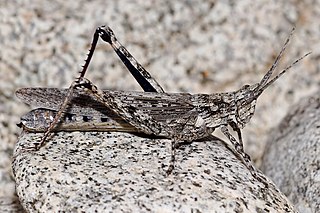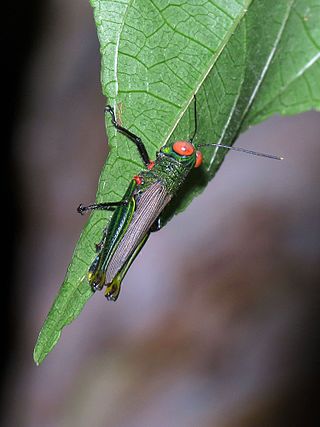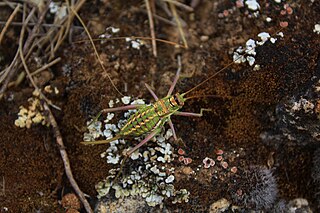
The Acrididae, or short-horned grasshoppers, are the predominant family of grasshoppers, comprising some 10,000 of the 11,000 species of the entire suborder Caelifera. The Acrididae are best known because all locusts are of the Acrididae. The subfamily Oedipodinae is sometimes classified as a distinct family Oedipodidae in the superfamily Acridoidea. Acrididae grasshoppers are characterized by relatively short and stout antennae, and tympana on the side of the first abdominal segment.

The grasshopper subfamily Acridinae, sometimes called silent slant-faced grasshoppers, belong of the large family Acrididae in the Orthoptera: Caelifera.

Oedipoda is the type genus of grasshoppers, in the subfamily Oedipodinae, mostly from the Palaearctic realm. The type species is the European "blue-winged grasshopper", Oedipoda caerulescens.

Rhytidochrotinae is a subfamily of grasshoppers from the family Acrididae with 20 genera and 47 species. This group is found from southern Central America to northern South America with most species distributed in montane forests. The highest concentration of species are found on the Pacific coast and in the West Andes of Colombia with 11 genera and 23 species registered. Many are brightly colored in reds, especially males, and most species are apterous.

Eumastacoidea is a superfamily within the order Orthoptera, suborder Caelifera. The family has a mainly tropical distribution and have sometimes been called "monkey grasshoppers".

Chorotypidae is a family of tropical Asian grasshoppers, formerly included within the family Eumastacidae. These grasshoppers have a head that rises above the level of the thorax and short antennae. Some species have reduced wings, others have wings that widen towards the tips and still others have a flattened leaf-like shape. They lack abdominal tympani.
Pyrgacris is a small genus of grasshoppers in the monotypic family Pyrgacrididae. The two species in the genus Pyrgacris are found only on Reunion Island.
Dericorythidae are a family of grasshoppers, in the Orthoptera: suborder Caelifera. Species in this family can be found in northern Africa, southern Europe and Asia.

The Tropidopolinae are a subfamily of Acrididae in the Orthoptera: Caelifera. Species can be found in Africa, southern Europe and Asia.

Romaleinae is a subfamily of lubber grasshoppers in the family Romaleidae, found in North and South America. More than 60 genera and 260 described species are placed in the Romaleinae.
Euschmidtiidae is a family of grasshoppers in the order Orthoptera. There are at least 60 genera and more than 240 described species in Euschmidtiidae, found in Sub-Saharan Africa and surrounding islands.

Acinipe is a genus of grasshoppers in the family Pamphagidae. There are more than 20 described species in Acinipe, found in Southern Europe and North Africa.

Paracinipe is a genus of grasshoppers in the family Pamphagidae. There are about 18 described species in Paracinipe, found in northern Africa and the Middle East.

Proctolabinae is a subfamily of grasshoppers in the family Acrididae. There are more than 20 genera and 210 described species which are found in South America.

Galidacris is a genus of grasshoppers belonging to the family Acrididae. They are found in South America within Colombia and Ecuador.

Pamphaginae is a subfamily of grasshoppers in the family Pamphagidae, with species found in Africa, Europe and Asia.

The Ommatolampidinae are a subfamily of grasshoppers in the family Acrididae, found in central and South America, and based on the type genus Ommatolampis. Derived from the "Ommatolampides" used by Brunner von Wattenwyl in 1893, the first use of the name in its current form was by Rodríguez et al. in 2013; this taxon appears to be paraphyletic.
The Egnatiinae are a subfamily of grasshoppers in the family Acrididae, found in central and South America, and based on the monotypic type genus Egnatius and erected by Bey-Bienko in 1951. Species have been recorded from parts of Africa, the Middle East and Asia, including Russia and China.

Ochrilidia is a genus of grasshoppers in the subfamily Gomphocerinae and typical of the tribe Ochrilidiini; it was erected by Carl Stål in 1873. Species have been recorded from Africa, the Middle East through to India and certain Mediterranean islands in Europe.

Parasteropleurus is a genus of bush crickets in the tribe Ephippigerini, erected by Barat in 2012 with insects that resembled Steropleurus. To date (2022) species have been recorded from the Iberian peninsula and North Africa.

















